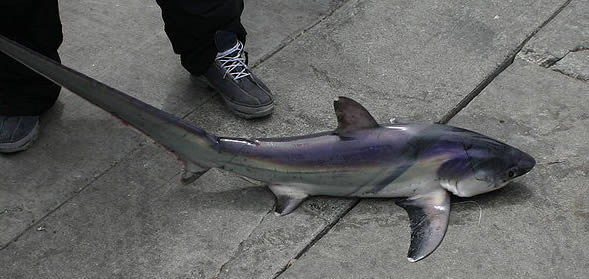Tag Archives: tresher shark
Why does the thresher shark have such a large tail?
The long caudal fin has puzzled marine biologists, since it has been difficult to see any use for this enlarged fin. Recent research has however unveiled that the sharks’ tail seems to play a vital role when the thresher shark hunt small prey fish. Thanks to its large tail, the thresher shark can easily swat and stun small fish in the water. This is probably also why thresher sharks often get their tails caught in long-line fishing equipment baited with small fish – the sharks are trying to stun the bait but end up captured instead.
The new findings doesn’t come as a surprise; there is for instance a report dating back to 1923 in which a thresher shark is described using its tail to catch food. The new study is however the first one to show exactly how it works.
The research, headed by Dr Chugey Sepulveda, has been carried out by biologist from The Pfleger Institute of Environmental Research in Oceanside, California, USA and the University of Massachusetts in Dartmouth.
While filming hunting sharks in the ocean, the research team was able to identify two distinct techniques for stunning prey. The thresher shark could waggle its body and surge forward, effectively forming a wave down its body ending in a tail flick, or the shark could simply position itself alongside the prey and make a sideways strike.
“The common thresher is for now, the only species that this feeding behaviour has been documented for. But we hypothesise that all three actively pursue prey with their elongate caudal fins,” said Dr Sepulveda.
There are three species of thresher shark:
- Common thresher (Alopias vulpinus)
- Pelagic thresher (Alopias pelagicus)
- Bigeye thresher (Alopias superciliosus)
The thresher shark study has been published in Journal of Fish Biology.
http://www3.interscience.wiley.com/journal/118483233/home?CRETRY=1&SRETRY=0
The research was supported by the National Science Foundation, the George T. Pfleger Foundation, the William H. and Mattie Wattis Harris Foundation, and the National Oceanic and Atmospheric Administration Bycatch Reduction and Engineering Program.
